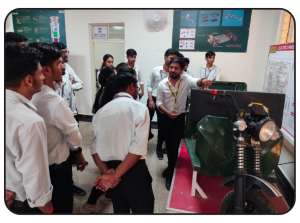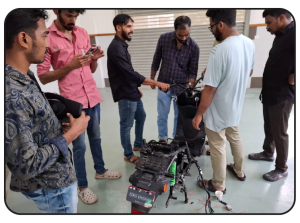Electric Vehicle Assembly Technician
This program offers hands-on training and certification in electric vehicle technology, focusing on assembly line techniques, EV components, and quality testing.

Next Cohort Starts: 30th September 2024
Book a Class, for Free

Online Training
8 Weeks Live Training from COE

Hybrid Training
7 Weeks Online + 1 Week Offline

Offline Training
8 Weeks Offline Training
Who is this Program For

ITI Polytechnic

12th Pass

Diploma
Hands on Training at our COE
Option 1
Centre of Excellence for Electric Vehicle at CSMSS, Aurangabad
Option 2
Centre of Excellence for Electric Vehicle at Galgotias University, UP
Brochure
Best-in-class content by leading faculty and industry leaders in the form of videos, cases and projects
Still have Questions?
Talk to our Experts…
Get Placement In
Top Skills You Will Learn
In this program, you'll master assembly line techniques, understand EV components, learn AC & DC basics, assemble battery packs, and focus on quality control and safety in electric vehicles.
Who Is This Programme For?
Diploma / ITI / 12th Pass students
Job Opportunities
EV assembly line technicians, quality control inspectors, and electrical system specialists. With the growing demand for electric vehicles, you'll find opportunities in EV manufacturing, component suppliers, and service centers, contributing to the industry's rapid expansion.
Minimum Eligibility
Bachelor’s Degree / ITI/ DIploma / 12th pass with minimum 50% or equivalent passing marks. No technical experience required.
Join the Electric Vehicle industry
By 2026, IDC predicts Electric Vehicle and cognitive computing spending will reach $52.2 billion. Electric Vehicle is one of the hottest professions.

36%
Annual Job Growth By 2026

50 M
Expected New Jobs By 2030

Rs. 1.2L - 1.8L
Average Annual Salary
Source: IESA Report
Source: IVCA-EY-Induslaw Report
Source: Glassdoor
Electric Vehicle Assembly Technician
Certified by NSDC
Complete all the courses successfully to obtain the certification from NSDC, supported by SMEV
• Complete the program of Electric Vehicle Assembly Technician
• Widely recognized and valued programmed in EV Engineering

ISIEINDIA Instructors
Learn from leading Industry oriented trainer, faculty and leaders
Our Expert Work At
Top companies from all around the world



Syllabus
Best-in-class content by leading faculty and industry leaders in the form of videos, cases and projects, assignments and live sessions
400+
Content Hours Available
100+
Industry Projects
10+
Case Study
4+
Project Work
Theoretical Classes
Assembly Technician
Mechanical Sub Assembly Technician
Assembling Parts
Service Technician Role
Industry Structure
Workshop
Assembly Standards (What is Assembly line?)
Assembly line Example& Types of assembly line methods
Step by Step Guide On Car Manufacturing Process
Design, Engineering & Car Manufacturing
Fire Safety
Classes of Fire
Types of Fire Extinguisher
Hight Voltage Safety
5 S’s & Types
5S Continued
Health & Hygiene
Frist Aid & Inhalation Protection
Hazards & Accidents
Manual Handling of loads & PPE
Tools & Handtools
Measuring tools
Nut & Bolt
How to Run an Efficient Assembly Line & Plan in Place
Set Realistic Targets
Communicate With Your Team
Implement Quality Control Measures
Minimize Part Count
Use Modular Components
Improve Ergonomics
Implement Quality Control Checks
Use Assembly Line Software
Avoid stress working in assembly line
Waste Reduction Management
Muda
7 Waste of Industry
Mura & Muri
What is Communication
Why Effective Communication
Importance of respecting personal space of colleagues
Constructive relationships between the organization
How employees judge respect
7 Steps to Respect
Managing Stress
Engineering drawing
Drawing Sheet Size
Standard Dimensioning Symbols/ Safety
Electrical Componets Symbols
Types of Electrical and Schematic Diagram
Pictorial and Block Diagram
Different Engineering drawings & Isometric view
Assembly Drawing
Orthographic projection
3D Projection & Geometrical Drawing
Reading Drawing
Basic Electricity (Generation, Advantages, Application)
Electrical Fundamentals Electron Theory, Atomic Structure, Atoms & Electrical Charges
Electrical Fundamentals (pt2):- Positive and Negative Ions ,Electron Flow
Insulators, conductors and semiconductor properties
Current Flow Theories, Terms Of Electricity
Voltmeter, ammeter, Ohmmeter Mulitmeter
Factors Affecting Resistance Ohm’s Law Electrical Power & Work
Activity; Identify the Phase, Neutral and Earth on power socket, use a tester to monitor AC power
Continuity test for fuses, jumper wires, fusible links, circuit breakers
Identify and Diagnose series, parallel, series- parallel circuits using Ohm’s law
Conductors & insulators, Wires, Shielding, Length vs. resistance
Resistor ratings, Capacitors and Coils
Activity: Perform the pratical on the connection of resistor and Continuity test for fuses
Introduction of Rectifier and inverter Circuit
Component Specification- Resistance, Inductor and Capacitor
Activity: Practice in joining wires using soldering Iron, Construction of Simple electrical circuits
Various terms such as +ve cycle, -ve cycle, Frequency, Time period. Single phase and Three phase supply. Terms like Line and Phase voltage/ currents.
Different type of electrical cables and their Specifications. Types of wires & cables, standard wire gauge (SWG)
Stripping wire insulation, cable colour codes and sizes ,, Crimping of connectors. Measure the gauge of the wire using SWG and outside micrometer
Activity: Prepare terminations, skin the electrical wires cables using wire stripper and cutter.
Quality Measurement Devices : – Checking of holes sizes by using Go/ No go gauge
GO & NO GO Inspection Practice, Plain Plug GO & NO GO Gauge
GO & NO GO Plain Ring Gauge
GO & NO GO Snap Gauge
Nut Thread Gauge
Feeler Gauge in Automobile
Vernier Caliper
Height Gauge
Bore Gauge
8 Dimensions of Quality
Overview of Vehicle Development Process
Material Inspection Report
Raw Material Inspection Report
In-Process Inspection Report
Inward Material Inspection Report
Pre Dispatch Inspection
Advance 5S for Quality Standard
Benefits of 7S
Monitoring and Controlling of 7S
Total Quality Management
Yellow Belt Certification Requirement
Fastening Methods: Bolting, Riveting, Welding
Bearings and Lubrication
Mechanical Joints and Assemblies Types of Materials: Metals, Plastics, Composites
Component Identification and Handling
Welding Machines: Tools used to join metals through processes like arc welding, MIG (Metal Inert Gas) welding, TIG (Tungsten Inert Gas) welding, etc.
Soldering and Brazing Equipment: Tools for joining metals using lower melting point filler materials.
Drills, Sanders, Grinders: Handheld power tools used for various tasks in fabrication and construction
Pneumatic Tools: Powered by compressed air, used for tasks like nailing, painting, etc.
Activity : Utilize hydraulic power for tasks like lifting heavy objects or powering machinery
Milling Machine,Drill Press
CNC Machine (Computer Numerical Control)
Injection Molding Machine
Milling Machine,Drill Press
CNC Machine (Computer Numerical Control)
Injection Molding Machine
History of EV
EV Scenario Global
Top EV Two-Wheeler Producers Company Market Share in % (2023)
Advantages and Disadvantages of EV Two Wheeler
Top 10 Electric 2 -Wheeler in India
Biggest Challenges Facing the EV Industry Today
Government Initiatives for Electric Vehicles in India
Introduction to Electric Vehicle Technology
Comparison of Electric Vehicle with IC engine vehicle based on emissions, range, fuel type.
Types of electric vehicle, BEV, HEV, PHEV and FCEV.
Brief description of powertrain components.
Experiment 1: List of Parts and Specifications of a 2Wheeler
History of Battery
Types of energy storage system
Cells – Cell Types Lead Acid / Liion/ NiMH/NiCad
Cell Selection and sizing, Handling Cells
Why Li-Ion Cells
Lithium Cells Working
Experiment 2: Perform the pratical to verify the Battery Nominal Voltage.
Battery Terminologies
Lithium Chemistry
Battery C- Rating
Cell Types – Form Factors
Lithium Cell Materials
Experiment 3:Check the Charging & Discharging techinques as per the C- rate of the battery.
Cell Assembly Model
Lekage Rate of the battery
Battery Case Design Principles
Battery Case Design – Model (series & parallel connections).
Experiment 4:To obtain the desire Output from Battery (series & parallel connections).
Role of the BMS
Function and parameter of bms
Types of BMS
About Battery thermal mangement System and their types.
Experiment 5:Perform the paratical to understand the Connection and role of BMS.
Making a Cell Arrangement
Assembling complete battery pack.
Experiment 6: Design a Complete Battery pack of 48V Output Voltage.
Introduction to motor
Construction of the motor
Working of the motor
Classification of the motors – Dc motor & Ac motor
Different Industrial appliances with different motors
Electric Vehicle Motors
Introduction of BLDC Motor
Hub Motor
Induction motors
Experiment 7: Introduction about the Different motors and their Wiring Connections.
Comparison of different types of Ev motors
V-I Characterstics of motor
Experiment 8: Measuring the Motor Power with the use of Multimeter.
Speed Regulation of the motor
Experiment 9: Measuring the motor RPM with different Rating Speed.
Torque Characterstics of motor
Peak Load
Balance and Unbalance Conditions
Experiment 10: Measuring Motor Torque and Plot the Torque vs. Speed Curve.
Power Train Components – Controller
Power Electronics Devices – Diode,Mosfet,Transistor
Converter Devices(AC – DC/DC -DC )
Experiment 11: Measurement of Voltage and current parameter.
Working of Motor Control System
Wire Harnesses and Connectors
Standard Colour code the controller
Experiment 12: Draw a Circuit Diagram of Wiring Harness of a 2Wheeler
Chassis mechanical Strength
Wheelbase & Castorl angle
Counter measure to prevent the parts from dropping
Experiment 13: Ergonomic measurement of the Chassis Inspection
To check the air pressure inside the vehicle tires is maintained at the recommended setting.
Experiment 14: Tires specification and its calculations
Drivetrain System
Brake and Suspension
EV Components Assembly
Tips for Removal and Installation
Steps Follow to Dismantle all the Body Parts of a 2/3 Wheeler Vehicle
Making the proper connection of 12 V and 48 V Circuit
Block Diagram of circuit Connections
Experiment 15:Perform the Complete circuit Connection of 2-wheeler
Change the direction of BLDC motor
Interchange the Polarity of power Flow
Experiment 16:Perform the practical while interchange the phase Sequences
Linear Hall Effect Sensor
Speed apporach of the BLDC motor
Experiment 17:Perform the practical how the Speed various with the use of throttle.
Fault Diagnosis System on motor,controller & throttle
Detection Techniques of components and Wiring harness
Experiment 18:Fault detection and diagnosis(FDD) on the EV components.
Charger Technologies
AC Charging Levels
DC Charging Levels
Charging Modes
Fast Charger Safety
Experiment 19:Understand the Simulation of On – board charging type.
Vehicles charging station –
Type of Charging station
Selection and Sizing of charging station, Components of charging station
Activity Sheet : Draw a Single line diagram of charging station.
QC and Testing (after Assembly 2/3 Wheeler EV)
Inspection of Cable connector
Experiment 20:Perform the Practical of Assemble and Disassemble Along with the Tag system.
Inspection of nuts, bolts and fasteners
Inspection of Control Switches
Steps to Carry out Inspection
Activity Sheet : Fill the Check list Box With observations
Diagnose, repair, and testing of EV vehicles and subsystems
Trace the light circuit – test bulbs, align head lamps, Aiming headlights
Trace the wiring circuit of lighting system
Activity Sheet : Fill the Check list Box With observations
Familiarization and Types & Classification of Switches, Steering lock cum ignition switch
Instrumentation and signaling system Gauges & Meters
Motor temperature gauge, Charging gauge, Speedometer, Tachometer diagnostics
Troubleshoot and Repair –
Acceleration and Braking in EV Functional Safety Understanding driving pattern, accessories usage (HVAC) and drive cycle and driver dependency.
PROJECT WORK
Admission Details
Candidates can apply to this Electric Vehicle Assembly Technician in 3 steps. Selected candidates receive an offer of admission, which is accepted by admission fee payment.
STEP 1

Submit Application
Tell us about yourself and why you want to do a PG certification
STEP 2

Application Review
An admission panel will shortlist candidates based on their application
STEP 3

Admission
Selected candidates can start the Electric Vehicle Assembly Technician program within
1-2 weeks
Admission Fee & Financing
The admission fee for this Electric Vehicle Assembly Technician is ₹ 20,000 (Incl. taxes). This fee covers applicable program charges and NSDC Certification.

Online
₹12500/-
(Incl. taxes)

Hybrid
₹15000/-
(Incl. taxes)

Offline
₹20000/-
(Incl. taxes)
Financing Options
We are dedicated to making our programs accessible. We are committed to helping you find a way to budget for this program and offer a variety of financing options to make it more economical.

Internet
Banking

Credit/Debit
Card

























